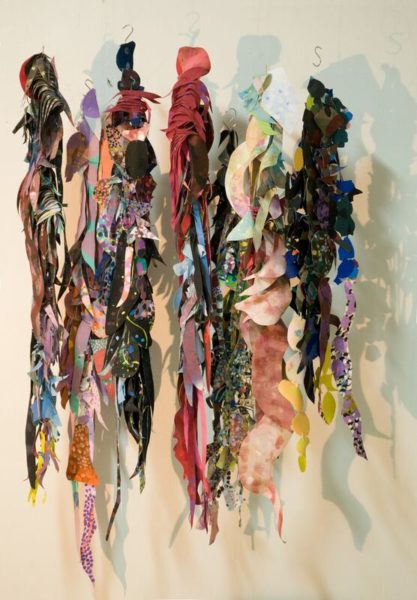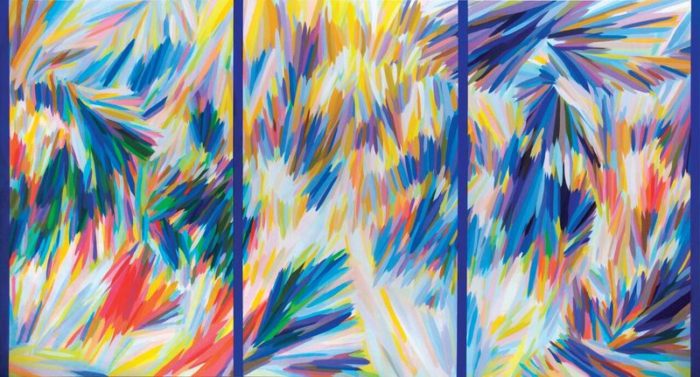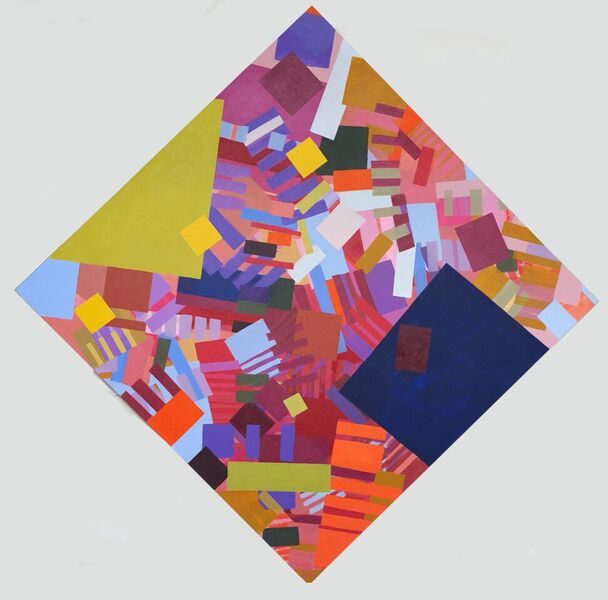
Jonathan Goodman: Please describe your early childhood in Palestine. What did your parents do for a living? Where in Palestine did you have a home? When did you leave Palestine for America?
Samia Halaby: My childhood in Palestine was comfortable and full of delightful discoveries. My father, despite losing his father and half his siblings at the age of twelve and being forced to leave school to support the family by selling bread on the streets of Jerusalem, eventually became an affluent businessman. My mother was a brilliant and elegant woman who fully enjoyed her education but did not have the opportunities to become professional. Her support helped me to realize what she had not been able to accomplish.
The fond memories of my childhood were damaged deeply by the terrifying experience of being driven from Palestine in 1948 when I was eleven years old. I have indelible memories resulting from the tragic events imposed by Zionist terror before 1948. Even today, I feel sharp pain when I hear the ongoing news of terror against Palestinians. The imposed suffering and attacks on children are particularly painful.
JG: Tell me about your life after Palestine, where did you move and what impact did it have on you as an artist?
SH: After exile my family took refuge in Beirut. I spent a formative period of my life – between 11 and 14 years of age – in this beautiful city. It had a substantial influence on my aesthetic: the blue sky meeting blue ocean; the beautiful, mature city trees and gardens; the mild sunny weather and architecture in the international style. But in 1951 my family decided to move to Cincinnati. The Midwest felt very earthy and practical. In the Midwest, you can stand at the edge of a road and see a vista of charming barns, hills, and fragments of forest. But I knew that someone owned every part of it. I missed the wildness of the ocean.

JG: Where did you go to college for your art studies? How important to you was American art at this time?
SH: Two and a half years after arriving in the US, I graduated high school and became a freshman at the University of Cincinnati. I was eager to take advantage of my university education to the fullest. Though I loved the drawing and painting classes, I focused on design. A background in design provided me with more opportunities, professionally, to support myself.
I earned a Bachelor of Science in Design from the University of Cincinnati and headed to Michigan to study painting at the Michigan State University. It was 1959, and abstract expressionism was still strong in New York. Many guest artists visited, some of whom were stars. But I did not know why these artists wanted to paint in a style so clearly reminiscent of earlier abstraction. When I was a graduate student at Indiana University, I worked with painters James McGarrell and William Bailey. But I wanted to go my own way–I needed to explore abstraction born of my admiration for Arab symmetry and Cubist painting.
JG: What happened after you finished your MFA? I understand that you taught, can you talk about that experience?
SH: A seventeen-year period of teaching followed after I received my MFA from Indiana University in 1963. My first teaching position was great fun. I found myself employed at the University of Hawaii in Honolulu, teaching mostly art history. I remember the pleasurable cultural change I experienced when I moved from the Midwest to Hawaii. People in Hawaii were far more relaxed; they were friendly, accepting, and open. From there I taught across many institutions, ultimately leading to a professorship at Yale University, where I remained for ten years.

JG: By yourself, you wrote a program enabling you quite literally to “play” the computer, improvising changes in form projected on a large screen, in response to live music. The imagery you use is entirely abstract. What does it feel like to “perform” visually in real time to music?
SH: The project you describe originated in the 1980s. I wanted to be an artist of my time, and I wanted to use the technology of my time. To really use a medium, one must know it extremely well. And so, to know the computer’s potential, one must write programs for it. Because sound and image are possible on the computer, and because these qualities are experienced together in the world of reality, I wrote programs with those attributes at the heart of my thinking. I improvised in concerts with percussionists. We formed a company and called ourselves the Kinetic Painting Group. During the late 80’s and 90’s, we performed all over New York, as well as travelling to Syria, Jordan, and the West Bank to play concerts.

JG: Can you talk about your recent works–two paintings that mean a lot to you?
SH: Since my first visit to The Last Supper at Santa Maria delle Grazie in Milan, I have had special respect for my neighbor on the Mediterranean pond. Although he is seen as Western and I am Arab, and there is a connection between us. I find myself closer to Leonardo’s scientific attitude than to the contemporary verbal acrobatics of postmodernism. After decades of artistic practice, I have realized that I learned a great deal from Leonardo’s The Last Supper. I am particularly interested in the surface of the painting and the illusion it contains.

SH: Between Two Landmarks is a good example of two important ideas in my painting: formulating shape based on principles of growth and the reflection of reality in abstract painting. Visual patterns are discernible–for example, how a highway divides and reshapes fields might be imitated by drawing a line over a shape and then redrawing the two resulting shapes. The title of the painting reveals its content: all manner of swiftly moving activity circles within the painting and gravitates to the two largest shapes. A few shapes fly over the composition. The schema is much like traffic and pedestrian activity faced at a city intersection.
JG: Finally, you are a mature artist. What would you like to accomplish in the next few years? Can your accomplishments be supported by an Arab intelligentsia living in New York?
SH: I do not invite only the Arab intelligentsia to appreciate my work, but rather art lovers from any part of the world. I am aware that as a Palestinian, I am often placed in a specific niche. I am indeed Palestinian and Arab, but my art and my thinking is international. In a year, I will have completed six decades of serious painting. To celebrate this, my ambition is to have a retrospective exhibition at a museum. I am also trying to complete an in-depth paper describing a theoretical view of art history, as well as a second edition of my book “Liberation Art of Palestine.”
Interview by Jonathan Goodman
Photographs provided by the artist.
